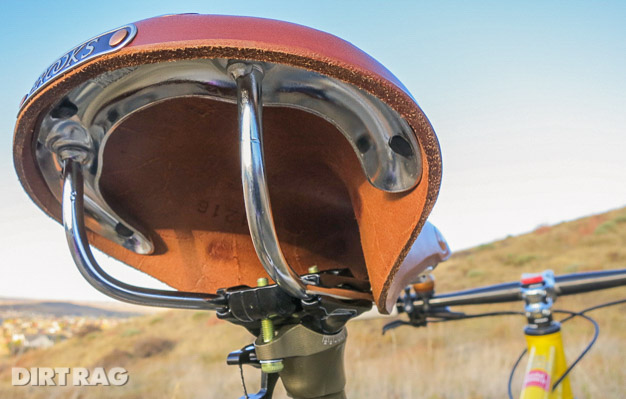First Impression: A proper English saddle
Originally posted on November 2, 2015 at 8:00 amNo one knows better than a woman how impractical and uncomfortable fashion can be. And no one knows better about suffering on a mountain bike than a singlespeeder. While I have no patience for the physical tyranny of high heels, I will—apparently—put a hard leather saddle on a derailleur-free, suspension-free mountain bike and commit myself to a long-term relationship potentially rife with discomfort.
I have long fancied a lovely Brooks as a fine way to top off a bike that requires a bit of deft and graceful handling to maneuver rocky trails. It’s all very proper and formal and British.
“Excuse me, big rock, pardon me. I’m just going to wiggle around you. Thank you.”

You are welcome to scoff that this is a dumb idea, but that’s not the point. Simply, the experiment is an exercise in curiosity combined with personal preferences for stiff saddles and lovely aesthetics. Why not put a classic leather Brooks on a mountain bike? I live in a place teeming with mountain bikers, but have never seen such a thing in the wild.
It’s true that the price for a leather saddle is high when compared to the risk of ending up with a very uncomfortable seat, especially when there are plenty of sufficient, well-priced options out there. I’m also aware that the care and feeding of a leather saddle, and its preference for staying out of the rain, makes it a seemingly impractical choice. Out of the box, I treated my saddle with Brooks’ own Proofride leather dressing, which conditions and “shower-proofs” the leather. Otherwise—considering the thing used to be a cow—I’m not intending to baby it much.
My curiosity led me to a Brooks Team Pro Chrome in the honey color. I chose it because Brooks lists the Team Pro under its “Road/MTB” line and because it is one of the narrower models (my preference) at 160mm wide—which is still much bigger than the 135mm Chromag Lynx DT it is replacing—but about the same width as the Brooks Cambium I run on my gravel bike.

The Team Pro has been in production for half a century, originating from the old B17 Competition. It has large, copper rivets hand-hammered in England, where the Brooks saddle line is crafted. (Don’t you wish Dr. Martin’s boots were still made in England? I sure as hell do.) The Team Pro has a reputation for being easier to break in (or not even needing it at all) and comes in multiple models, including women’s versions, lighter-weight iterations with titanium rails and unique colors like red and green.
Brooks saddles have been “curated” and “hand-crafted” long before my ironically bearded Millennial cohorts co-opted those terms. They’re beautifully packaged. Receiving one in the mail takes you back to a time when children got only one present under the Christmas tree and it was artfully wrapped with brown paper and twine … even if you weren’t alive during those times.
My first two singletrack rides on the Brooks were enlightening. On the first ride, I stopped every mile to futz with the saddle’s position before learning what I could have read online: these saddles sometimes need to run with a slight nose-up or nose-down position so that your body is properly cradled.

Once I tilted the nose up just a tad, the Team Pro felt immediately comfortable. Singlespeeders have to do a lot of standing while climbing and aren’t always able to gently ease themselves back into a seated position after difficult efforts. Sometimes you land with an exhausted thud. With the saddle running slightly nose-high, my derriere settled effortlessly and I didn’t need to squirm to get comfortable again.
Correct positioning also negated much of the sliding around you’ll inevitably do if you’re only wearing Spandex while riding an ultra-smooth leather saddle. Still, it might be time to invest in some jean jorts for extra grip.
The only problem with a slightly tilted-up position is that it’s nearly impossible to shift around on the saddle. I am not able to scoot forward for on-the-nose seated climbs. More rides will tell if this is a serious issue and if I need to continue experimenting with the saddle’s angle.
I do enjoy the feel of the Team Pro’s dropped sides when going into tight turns. Lean the bike over and the saddle rests itself reassuringly against your inner thigh. Getting totally behind the seat will take some getting used to, however; the edge of the leather is a bit grabby in that it’s not smooth and rounded off, nor is it padded. Sliding back up and over the saddle requires a bit of extra mental awareness.

Critically, I chose the “Chrome” version of the Team Pro because it is one of the few models to lack saddlebag tabs, which I worried would catch my shorts too easily if I had to get way, way back. But, let’s be honest: my singlespeed is not my “get rad” bike so scraping my butt on the rear tire doesn’t happen very often. Thanks to my dropper post, I can cheat around that issue, but will try to refrain from using it while I’m riding this saddle.
Will the Team Pro be “better” than the reliable Chromag I ran for several years? I can’t yet answer that, but it unequivocally made my singlespeed more beautiful (which counts for something, I say). Should you try this, too? You can do whatever you want. I’ll get back to you in a few months after the Brooks and I have had a chance to spend some quality time together.
- Model: Brooks Team Pro Chrome
- Length: 273mm
- Width: 160mm
- Height:67mm
- Weight: 540g
- Frame: chromium plated steel